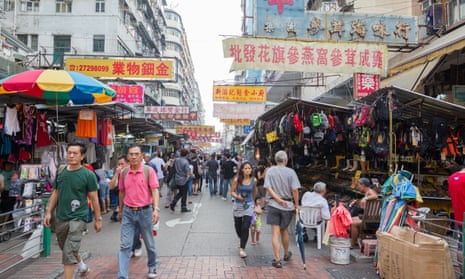Sham Shui Po has long been a working-class district of Hong Kong. This humble area hides an intriguing press of markets, shops, stalls, eateries – and, inevitably, a touch of hipster resurgence.
We start our wander with that most Hong Kong of meals: a bowl of noodles. There are very few restaurants in Hong Kong that make their own any more, and there are fewer still that make it the old-fashioned way, by kneading the dough with a bamboo pole. At Lau Sum Kee Noodle (48 Kweilin Street, Sham Shui Po), owner Lau Fat-cheong makes them fresh every day using this technique. He balances on the end of a large bamboo pole, bouncing up and down to knead his springy, al dente noodles. The house specialties are the wonton soup noodles, or noodles tossed with dried shrimp roe.

Suitably fortified, we’re heading into the maze that is the Golden Shopping Centre (Golden Building, 146-152 Fuk Wa Street, Sham Shui Po). Time was, this building was stuffed full of stores selling pirated software and DVDs. Every so often the shout would go up and you’d be hustled out of the store, the shutters would clang down behind you, and a few seconds later a policeman would wander past. These days, the arcade is far more legitimate, selling a huge range of tech, video games and accessories.
But if you’re looking for a true electronics bargain, head straight for the Apliu Street flea market. This strip of open-air street stalls is a goldmine, selling transistors and resistors, vintage cameras, sparkling lengths of LED lights, second-hand power tools and pre-owned TV remotes. Behind the main strip, shops stock everything from multimeters and tripods to night-vision goggles and pen cameras.

Just above Ap Liu Street, Paul Au runs his vinyl fiefdom. He’s not just a little into LPs. He loves them so much that his entire house is dedicated them, at the expense of pretty much everything else. The 28 square metres (300 sq ft) that make up Au’s flat/shop Vinyl Hero (Flat D, 5/F Wai Hong Building, 239 Cheung Sha Wan Road) contain some 400,000 records, stacked up to the ceiling. Go ready to hunt, and you’re sure to find a gem. Do call ahead before you make a house visit.
Head down the road in search of Chan Cheuk-ming, better known as “Brother Ming”. The owner of the humble Pei Ho Counterparts (278 Tai Nan Street, Sham Shui Po) is a Sham Shui Po celebrity. Brother Ming isn’t famed for his food, but his charity. For years now he’s been handing out free meals to the impoverished and homeless of the district. Grab an energy boost in the form of a classic Hong Kong-style French toast: two slices of bread that are egged, deep fried, and served with a huge pat of butter and a healthy drizzle of golden syrup. Then pay it forward by buying a meal or two more for someone in need.

Sham Shui Po is the centre of the city’s fabrics trade, with streets lined with shops selling bolts of every kind of material and fabric under the sun. Just down the road, Alri Star Leather Factory keeps the district’s heritage alive with a hipster touch. You can buy leathers of all kinds here, and also the punches, cutters and burnishers you’ll need to go from hide to homemade artisanal goods. Lacking the time or the inclination? Alri also sells handmade, and already completed, leather goods – as does Brothers Leathercraft a few shops down.
Afterwards drop by Common Room and Co, a community-minded combination art gallery, bookstore, maker-space and coffee shop, or Cafe Sausalito for something single-origin and cold-brewed.
Time for another bite – the most famous of our route. When chef Mak Kwai Pui left the Four Seasons hotel in Hong Kong, he decided it was time for a change from fine-dining Cantonese fare. And so in 2009 he opened Tim Ho Wan, a humble 20-seater restaurant serving everyday dim sum with a twist of technique. It picked up a Michelin star a year later, and has been widely touted as the world’s cheapest Michelin-starred restaurant. That means the queues tend to be long, but at least they’re worth it: especially for chef Mak’s invention, the baked char siu bao: soft, sweet, baked buns filled with tender roast pork.

On the way to dessert, stop by nearby Bo Wah Paper Effigies (2C Fuk Wing Street, Sham Shui Po). In Cantonese culture, the living burn paper offerings for their ancestors. These can range from prayer papers to paper currency and extravagant effigies of paper houses, clothing or cars. At Bo Wah, tradition gets an update, thanks to the young Au Yeung Ping-chi, who has fashioned paper representations of giant robots, fishing rods and scuba gear. After all, no one said the afterlife had to be boring.
Grab a sweet bite at Kung Wo Beancurd Factory (118 Pei Ho Street, Sham Shui Po), which has barely changed since opening here in the 60s. In the doorway, cubes of tofu sizzle away on large pans. Inside, the packed tables make it clear this restaurant is a Hong Kong favourite. Order the fragrant, sweet and smooth dou fu fa (tofu pudding).
Last of all, head up the road for a reminder of the past in the neo-classical colonial edifice that was once the North Kowloon Magistracy. It’s an imposing courthouse edifice that looks entirely out of place in this humble district: but what better way for the city’s rulers to impress their power on the populace? These days, though, the building is the Hong Kong base of the Savannah College of Art and Design, better known as SCAD. A sensitive conservation effort has earned the site a Unesco nod: one courtroom and a jail cell have been preserved, and the school is open to the public through twice-daily tours.
